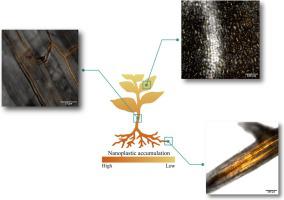当前位置:
X-MOL 学术
›
Sci. Total Environ.
›
论文详情
Our official English website, www.x-mol.net, welcomes your
feedback! (Note: you will need to create a separate account there.)
Quantification of nanoplastic uptake and distribution in the root, stem and leaves of the edible herb Lepidum sativum
Science of the Total Environment ( IF 8.2 ) Pub Date : 2023-11-25 , DOI: 10.1016/j.scitotenv.2023.168903 Harshit Sahai 1 , María Jesús Martínez Bueno 2 , María Del Mar Gómez-Ramos 2 , Amadeo R Fernández-Alba 2 , María Dolores Hernando 3
Science of the Total Environment ( IF 8.2 ) Pub Date : 2023-11-25 , DOI: 10.1016/j.scitotenv.2023.168903 Harshit Sahai 1 , María Jesús Martínez Bueno 2 , María Del Mar Gómez-Ramos 2 , Amadeo R Fernández-Alba 2 , María Dolores Hernando 3
Affiliation

|
This study confirms the uptake, translocation and bioaccumulation of 100 nm polystyrene nanoplastics in the root, stem and leaves of the plant Lepidum sativum at exposure concentrations ranging from environmentally realistic 10 μg/L up to a high of 100 mg/L. Accumulation in plant tissues was characterised by aggregation in the intercellular spaces and heterogeneous distribution. Nanoplastic presence was confirmed in the root tips, root surface and stele, lateral roots, root hairs, stem vascular bundles, leaf veins and mesophyll, as well as leaf epidermis including stomatal sites. Quantification results show that majority of the particles were retained in the root and accumulation in stem and leaves was only 13 to 18 % of the median value in roots. There was a reduction of 38.89 ± 9.62 % in the germination rate, 55 % in plant fresh weight, as well as in root weight (> 80 %), root length (> 60 %), shoot weight (51 to 78 %) and number of lateral roots (> 28 %) at exposure concentrations at and above 50 mg/L. However, lower, environmentally probable exposure concentrations did not affect the plant health significantly. Our results highlight the urgent need for further exploration of this issue from the point of view of food safety and security.
中文翻译:

食用草本植物 Lepidum sativum 根、茎和叶中纳米塑料吸收和分布的定量
这项研究证实了 Lepidum sativum 植物的根、茎和叶中 100 nm 聚苯乙烯纳米塑料的吸收、易位和生物累积,暴露浓度范围从环境实际的 10 μg/L 到最高的 100 mg/L。植物组织中的积累特征是细胞间隙中的聚集和不均匀分布。在根尖、根表面和中柱、侧根、根毛、茎维管束、叶脉和叶肉以及包括气孔部位的叶表皮中均证实存在纳米塑料。定量结果显示,大部分颗粒物保留在根部,茎叶中的积累量仅为根部中值的13%至18%。发芽率下降 38.89 ± 9.62 %,植物鲜重下降 55 %,根重 (> 80 %)、根长 (> 60 %)、芽重 (51 至 78 %) ) 和暴露浓度等于或高于 50 mg/L 时的侧根数量 (> 28 %)。然而,较低的、环境可能的暴露浓度不会对植物健康产生显着影响。我们的结果凸显了迫切需要从食品安全和保障的角度进一步探讨这个问题。
更新日期:2023-11-25
中文翻译:

食用草本植物 Lepidum sativum 根、茎和叶中纳米塑料吸收和分布的定量
这项研究证实了 Lepidum sativum 植物的根、茎和叶中 100 nm 聚苯乙烯纳米塑料的吸收、易位和生物累积,暴露浓度范围从环境实际的 10 μg/L 到最高的 100 mg/L。植物组织中的积累特征是细胞间隙中的聚集和不均匀分布。在根尖、根表面和中柱、侧根、根毛、茎维管束、叶脉和叶肉以及包括气孔部位的叶表皮中均证实存在纳米塑料。定量结果显示,大部分颗粒物保留在根部,茎叶中的积累量仅为根部中值的13%至18%。发芽率下降 38.89 ± 9.62 %,植物鲜重下降 55 %,根重 (> 80 %)、根长 (> 60 %)、芽重 (51 至 78 %) ) 和暴露浓度等于或高于 50 mg/L 时的侧根数量 (> 28 %)。然而,较低的、环境可能的暴露浓度不会对植物健康产生显着影响。我们的结果凸显了迫切需要从食品安全和保障的角度进一步探讨这个问题。

















































 京公网安备 11010802027423号
京公网安备 11010802027423号